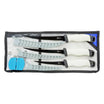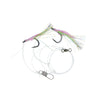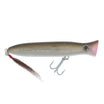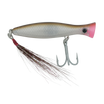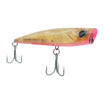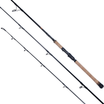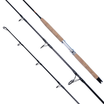Sand Eel Jigging Bluefin Tuna
Capt. Mike Hogan and Eric Harrison head East of Chatham searching for tuna feeding on sand eels. When fish are suspended mid-water and near the bottom grubbing on sand eels, the Hogy Sand Eel Jig is an excellent presentation for getting deep quickly and covering the water column.

SEARCH AND DROP TECHNIQUE:
With the recent developments of fish-finding technology, this technique is becoming more and more popular. In this technique, you are literally cruising around looking for targets to drop on. Search and drop is the most tactical variation of jigging in that the captain and crew work hand in hand ready to coordinate the drop. Each angler is poised and prepared for the drop at a moment's notice. This is a handy skill to have mastered when there are fish in the area that are hesitant to eat. The more time spent with the lures directly in front of their noses, the more likely you are to hook up.
STEPS:
1. Identify an active area.
2. Find a happy cruising speed, maybe around 8 knots for searching
3. Have anglers holding their rods at all times, ready to free-spool their lure at a moment's notice.
4. Along with watching the electronics, constantly look for changes in the water and be ready to cast at any water that looks “pushed” or otherwise altered.

TWITCH JIGGING TECHNIQUE:
Twitch jigging is a variation of the slow jig with the only difference being a series of sharp, fast twitches in the rod. It’s almost like you are vibrating the lure with rapid rod tip twitches. This technique works particularly well with the Hogy Sand Eel Jig. It's long, slender profile responds with a lot of jerking rod tip motions. The huge benefit of this technique is that you can really dial in a certain depth. This is a useful method when “sniping” fish you have identified on the fish finder.
STEPS:
1. Drop to a specific depth that you are targeting.
2. Twitch your rod with fast short movements.
3. Every few moments, change the depth by 10’, and repeat.
4. Once you have too much line out from boat drift, reel in and repeat.
BENEFITS:
1. Stay in a key strike zone for a very long time.
2. Faster motions might trigger a reaction strike.
3. Allows metal lure depth, softbait action.

FAST JIGGING TECHNIQUE:
Fast jigging is associated mostly with metals but is suitable for soft plastics and Epoxy Jigs, too. The bites tend to be more violent but you need to also pay careful attention to bites on the drop. Fast jigging is the best way to cover all levels of the water column and can often draw reaction strikes. It’s very hands-on and interactive.
STEPS:
1. Drop to the bottom.
2. Engage and reel quickly while jerking the rod while cranking.
3. Stop at the maximum depth where you expect to leave the fish.
4. Drop back to the bottom and repeat.
5. Once you have too much line out due to boat drift, reel all the way up and start over.
BENEFITS:
1. Easily cover all levels of the water column. The speed is good in that you can cover all the levels frequently.
2. The speed is also good for drawing a reaction strike.
3. Speed jigging is a good way to cut down on dogfish bites.
4. Heavy Jigs and frequent re-positioning are ideal for heavy currents




















